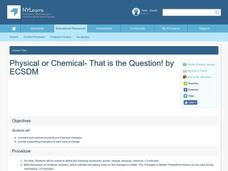American Chemical Society
Change in Temperature - Exothermic Reaction
Alone, or as part of the intended unit on chemical reactions, this activity allows learners to experience an exothermic reaction. Here, learners add calcium chloride to a baking soda solution and watch the temperature rise! They will...
Curated OER
Physical or Chemical- That is the Question!
Students observe the differences between physical and chemical changes in properties. Through the use of an interactive presentation, the students compare and contrast the changes and provide supporting examples of each type of change.
Curated OER
Investigating the Change
Sugar crystal growth is observed as an example of physical change and cabbage juice pH indicator is used to demonstrate chemical change. The crystal growth is tracked over five days. The cabbage juice experiment is involved and can also...
Curated OER
Fun With Chemical Changes
Looking for a terrific chemistry lesson plan for your 5th graders? This one could be for you! After a teacher-led demonstration, learners are broken up into groups and perform an experiment using cabbage juice, water, window cleaner, and...
Curated OER
States of Matter and Chemical/Physical Changes Stations
Young scholars break into four groups, starting at different stations. Each station should take about 10 minutes depending on prior knowledge of the topic. They then rotate when everyone is finished to the next station and discuss...
Curated OER
Properties and Perfectly Polymeric Sodas
Students examine physical and chemical properties of plastics, interfaces of plastics, and forms of plastics. In three lab activities, students discover the two characteristic responses of plastics to heating, thermoplastic or...
American Chemical Society
Heating Can Make a Change That Cannot Go Back Again
Heat is a gateway to change. While exploring the properties of baking powder, pupils learn that some heat-related changes are permanent. Using an animation, the lesson uses chocolate chip cookies as an example.
Curated OER
Cents-ible Chemistry-Analysis of the Metal in a Penny
Students determine the base metals and surface metals in a penny. In this analysis of metals lesson plan, students determine the density of five pennies minted in different years. They use different chemicals such as hydrochloric acid,...
Curated OER
What's the Matter? (Living and Non-Living Things)
Understand how chemical reactions recombine atoms to create the "chemicals of life". An experiment, showing the basic chemical reactions of an iron nail or a match, helps young children start their understanding of permanent changes.
American Chemical Society
Chemical Reactions and Color Change
Colors are more than just a pretty effect. Learners explore what color change means in terms of chemical properties and reactions. They create a pH solution using cabbage leaves and observe the changes when acids and bases are added.
Curated OER
Chemical Composition of American Coins
Students investigate the chemical composition of pennies dated 1983 or later. For this chemical composition of American coins lesson plan, students scratch the surface of the penny to expose the zinc core. They put the penny in...
Beyond Benign
Packed Up Properties
Determine physical properties of potential packaging materials. Continuing from previous lessons in the series, the resource asks groups to identify physical properties of the substances. They test for conductivity, solubility, water...
Curated OER
Changes in Nature
The goal of this science lesson is to have youngsters be able to identify the physical and chemical changes in the carbon cycle, and water cycle due to weathering. The in-class inquiry/experiment is quite interesting and easy to...
Curated OER
Physical/Chemical Properties of a Burning Candle
Students investigate the physical and chemical properties of a candle before and after it is lit. They conduct a burning candle experiment, and complete a KWL chart and worksheet, recording the results of the investigation.
Curated OER
Exploring the Physical and Chemical Properties of Polymers
Students identify the physical and chemical properties and explore the differences. In physical and chemical property lesson students test polymers for the differences between the physical and chemical properties, record their...
Curated OER
The Elements
Fifth graders explore the differences between elements. In this elements and atoms lesson students complete an activity that shows how chemicals react to a flame test.
American Chemical Society
From Gas to Liquid to Solid
From gas to liquid condensation to solid frost, water undergoes phase changes before students' eyes! Using ice, salt, water, and a metal can, they set up an investigation that can be used in a physical science setting, or as part of a...
American Chemical Society
Evaporation
This is one in several lessons that explore the relationship between temperature and phase changes of water. After some discussion, elementary physical scientists place wet paper toweling on a hot and a room-temperature water bag and...
Curated OER
Chemical Changes
Students compare types of chemical change. In this chemical reaction lesson, students use a variety of household items to investigate different types of chemical change. Students will engage in a discussion about the dangers of chemicals...
Curated OER
Change It
Fourth graders expand their knowledge about how the physical properties of a substances can be changed. They are given multiple opportunities, using first-hand experiences and familiar objects in different contexts, to identify...
American Chemical Society
Using Color to See How Liquids Combine
Blue-tinted water is added to unknown liquids that have been tinted yellow to find out how they interact. This is a memorable activity that is part of an investigation on the properties of liquids, which is part of a unit on the...
American Chemical Society
Using the Combining Test to Identify Unknown Liquids
Once investigators have learned how their mystery liquids interact with water during the preceding activity, they now use their observations to identify them. This is an ideal conclusion to the mini unit on the properties of water.
Baylor College
Fuel for Living Things
During a three-part lesson plan, learners make a cabbage juice pH indicator and use it to analyze the waste products of yeast after feeding them with sugar. The intent is to demonstrate how living organisms produce carbon dioxide, which...
American Chemical Society
Curious Crystals
Crystals are more than meets the eye! Can learners tell them apart simply by observation? As they examine five samples with a magnifier, they find that appearance alone is not enough. This serves as an introduction to a mini unit on...

























